RBSE Solutions for Class 12 Maths Chapter 9 Differential Equations Ex 9.3
Rajasthan Board RBSE Solutions for Class 12 Maths Chapter 9 Differential Equations Ex 9.3 Textbook Exercise Questions and Answers.
Rajasthan Board RBSE Solutions for Class 12 Maths in Hindi Medium & English Medium are part of RBSE Solutions for Class 12. Students can also read RBSE Class 12 Maths Important Questions for exam preparation. Students can also go through RBSE Class 12 Maths Notes to understand and remember the concepts easily.
RBSE Class 12 Maths Solutions Chapter 9 Differential Equations Ex 9.3
Question 1.
\(\frac{x}{a}+\frac{y}{b}\) = 1
Answer:
The given equation is:
\(\frac{x}{a}+\frac{y}{b}\) = 1
Differentiating equation (1) w.r.t. 'x', we get

Again, differentiating equation (2) w.r.t. 'x', we get
\(\frac{d^2 y}{d x^2}\) = 0
or y'' = 0
Hence, equation (3) is the required differential equation.
Hence proved.

Question 2.
y2 = a(b2 - x2)
Answer:
The given equation is
y2 = a(b2 - x2)
Differentiating equation (1) w.r.t. 'x', we get
2y\(\frac{d y}{d x}\) = a(- 2x)
or y\(\frac{d y}{d x}\) = - ax
Again, differentiating equation (2) w.r.t. 'x', we get
y \(\frac{d^2 y}{d x^2}+\left(\frac{d y}{d x}\right)^2\) = - a ...... (3)
Substituting the value of - a from equation (3) in equation (2), we get
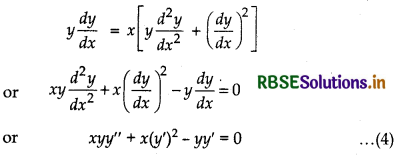
Hence, equation (4) is the required differential equation.
Question 3.
y = ae3x + be-2x
Answer:
The given equation is:
y = ae3x + be-2x ...... (1)
Differentiating equation (1) w.r.t. ‘x’, we get
\(\frac{d y}{d x}\) = 3ae3x - 2be-2x ....... (2)
Again, differentiating equation (2) w.r.t. ‘x’, we get
\(\frac{d^2 y}{d x^2}\) = 9ae3x + 4be-2x ..... (3)
Multiplying equation (1) by 2 and then adding in equation (2)
2y + \(\frac{d y}{d x}\) = 2ae3x + 2be-2x + 3ae3x - 2be- 2x
or 2y + \(\frac{d y}{d x}\) = 5ae3x
or ae3x = \(\frac{2 y+\frac{d y}{d x}}{5}\)
Now, multiply equation (1) by 3 and subtract from equation (2), we get

Hence, equation (4) is the required differential equation.

Question 4.
y = e2x (a + bx)
Answer:
The given equation is
y = e2x (a + bx)
or ye-2x = a + bx ......... (1)
Differentiating equation (1) w.r.t. ‘x’, we get
\(\frac{d y}{d x}\)e-2x - 2e- 2x y = b ....... (2)
Again, differentiating equation (2) w.r,t. ‘x’, we get

Hence, equation (3) is the required differential equation.
Question 5.
y = ex (a cos x + b sin x)
Answer:
The given equation is:
y = ex (a cos x + b sin x)
or ye-x = a cos x + b sin x ........ (1)
Differentiating equation (1) w.r.t. 'x', we get
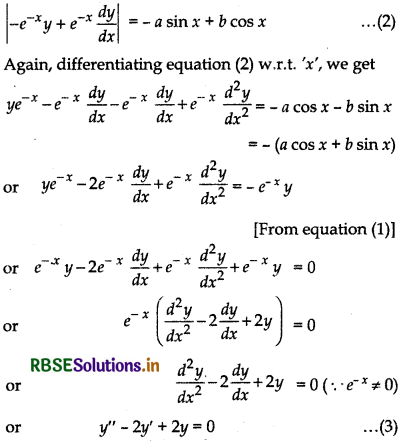
Hence, equation (3) is the required differential equation.

Question 6.
Form the differential equation of the family of circles touching the y-axis at origin.
Answer:
Let c denote the family of circles touching y-axis at origin. Let (a, 0) be the co-ordinates of the centre and a be the radius of any member of the family. Therefore, equation of family c is:
(x - a)2 + y2 = a2
or x2 - 2ax + a2 + y2 = a2
or x2 + y2 = 2ax ........ (1)
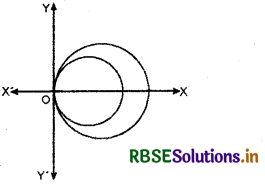
Differentiating equation (1) w.r.t. 'x', we get
2x + 2y\(\frac{d y}{d x}\) = 2a or x + y\(\frac{d y}{d x}\) = a
Putting the value of a in equation (1), we get

or 2xyy' + x2 = y2
Hence, equation (2) is the required differential equation.
Question 7.
Form the differential equation of the family of parabolas having vertex at origin and axis along positive y-axis.
Answer:
Equation of parabola having vertex at the origin and axis along positive y-axis is:
x2 = 4ay .......... (1)
Differentiating equation (1) w.r.t. ‘x’, we get
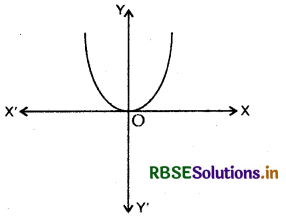
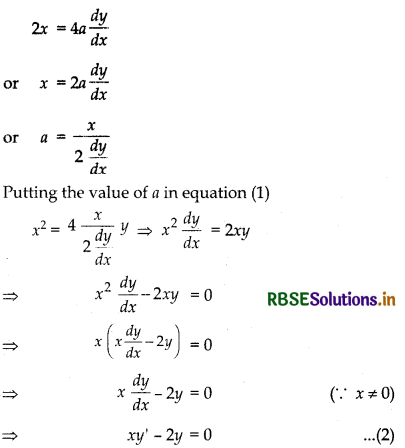
Hence, equation (2) is the required differential equation.

Question 8.
Form the differential equation of the family of ellipses having foci on y-axis and centre at origin.
Answer:
Equation of family of ellipses having foci on y-axis and centre at origin (0, 0).
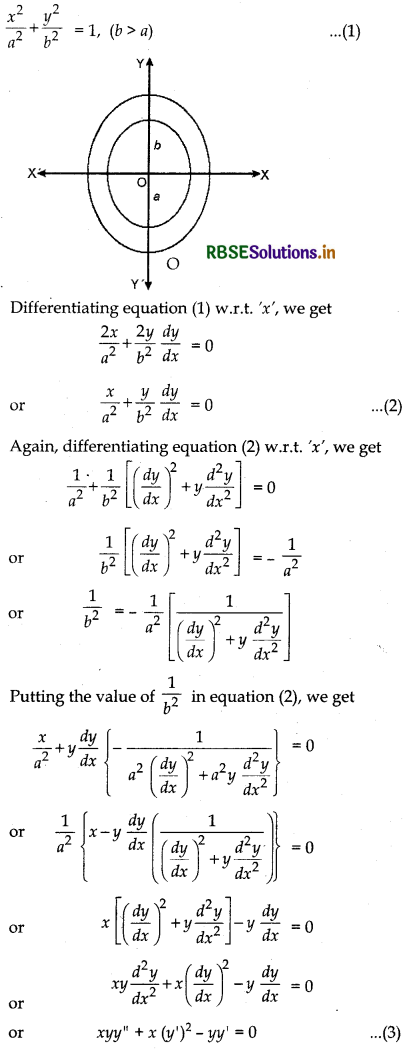
Hence, equation (3) is the required differential equation.
Question 9.
Form the differential equation of the family of hyperbolas having foci on x-axis and centre at origin.
Answer:
Equation of family of hyperbolas with centre at the origin and foci along x-axis is:
\(\frac{x^2}{a^2}-\frac{y^2}{b^2}\) = 1
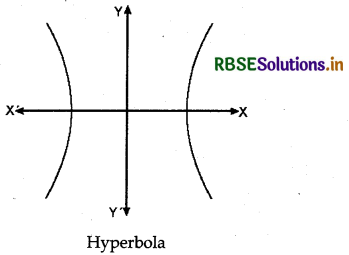
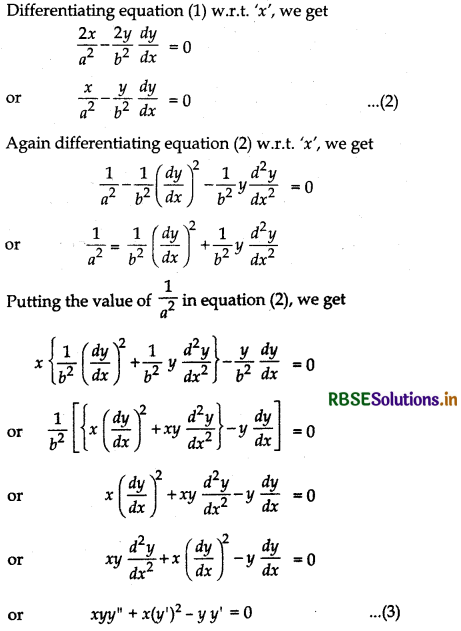
Hence, equation (3) is the required differential equation.

Question 10.
Form the differential equation of the family of circles having centre on y-axis and radius 3 units.
Answer:
Equation of family of circles with centre (0, b) and radius 3 units.
(x - 0)2 + (y - b)2 = 9
or x2 + (y - b)2 = 9 ....... (1)

Hence, equation (2) is the required differential equation.
Question 11.
Which of the following differential equations has y = c1ex + c2e-x as the general solution?
(A) \(\frac{d^2 y}{d x^2}\) + y = 0
(B) \(\frac{d^2 y}{d x^2}\) - y = 0
(C) \(\frac{d^2 y}{d x^2}\) + 1 = 0
(D) \(\frac{d^2 y}{d x^2}\) - 1 = 0
Answer:
The given equation is:
y = c1ex - c2e-x ....... (1)
Differentiating equation (1) w.r.t. 'x', we get
\(\frac{d y}{d x}\) = c1ex - c2e-x ............ (2)
Again, differentiating equation (2) w.r.t, 'x', we get
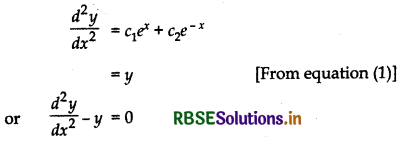
Hence, (B) is the correct answer.

Question 12.
Which of the following differential equations has y = x as one of its particular solution?
(A) \(\frac{d^2 y}{d x^2}\) - x2 \(\frac{d y}{d x}\) + xy = x
(B) \(\frac{d^2 y}{d x^2}\) + x \(\frac{d y}{d x}\) + xy = x
(C) \(\frac{d^2 y}{d x^2}\) - x2 \(\frac{d y}{d x}\) + xy = 0
(D) \(\frac{d^2 y}{d x^2}\) + x \(\frac{d y}{d x}\) + xy = 0
Answer:
The given equation is:
y = x ............ (1)
Differentiating equation (1) w.r.t. ‘x’, we get
\(\frac{d y}{d x}\) = 1 ....... (2)
Again, differentiating equation (2) w.r.t. ‘x’, we get
\(\frac{d^2 y}{d x^2}\) = 0 ......... (3)
Putting the values of \(\frac{d^2 y}{d x^2}\) = 0 and y = x in equation
\(\frac{d^2 y}{d x^2}\) - x2\(\frac{d y}{d x}\) + xy = 0
L.H.S. = 0 - x2 × 1 + x.x
= - x2 + x2 = 0 = R.H.S.
Hence, (C) is the correct answer.

- RBSE Class 12 Maths Notes Chapter 13 Probability
- RBSE Class 12 Maths Notes Chapter 12 Linear Programming
- RBSE Class 12 Maths Notes Chapter 11 Three Dimensional Geometry
- RBSE Class 12 Maths Notes Chapter 10 Vector Algebra
- RBSE Class 12 Maths Notes Chapter 9 Differential Equations
- RBSE Class 12 Maths Notes Chapter 8 Application of Integrals
- RBSE Class 12 Maths Notes Chapter 7 Integrals
- RBSE Class 12 Maths Notes Chapter 6 Application of Derivatives
- RBSE Class 12 Maths Notes Chapter 5 Continuity and Differentiability
- RBSE Class 12 Maths Notes Chapter 4 Determinants
- RBSE Class 12 Maths Notes Chapter 3 Matrices